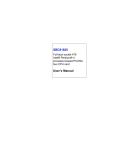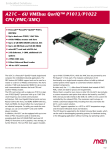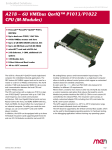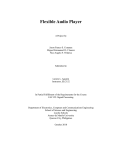Download ADC-EMC User Manual AD001174 Version 1.3
Transcript
ADC-EMC User Manual AD001174 Version 1.3 ADC-EMC User Manual Copyright © 2007 Alpha Data Parallel Systems Ltd. All rights reserved. This publication is protected by Copyright Law, with all rights reserved. No part of this publication may be reproduced, in any shape or form, without prior written consent from Alpha Data Parallel Systems Limited. Alpha Data Parallel Systems Ltd. 4 West Silvermills Lane Edinburgh EH3 5BD Scotland UK Phone: +44 (0) 131 558 2600 Fax: +44 (0) 131 558 2700 Email: [email protected] ADC-EMC User Manual Reserved rights This manual is designed to provide outline information only. Alpha Data has a continual policy of improving its products; hence it reserves the right to change product specification without prior warning. Alpha Data cannot accept any liability for loss or damages arising from the use of this manual or the use of products detailed within it. Trademark acknowledgements PCI TM, PCI-X TM, PCI EXPRESS® and PCIe® are registered trademarks of PCISIGTM. Warranty and Support All Alpha Data products enjoy parts and labour warranty for 12 months after purchase. The warranty is based on the customer returning the defective goods to Alpha Data for repair or replacement, which will be at the discretion of the company. The warranty does not cover damages caused by negligence, misuse, and normal wear and tear. No liability is accepted by the company for any damage caused by the use of its hardware or software. All goods from Alpha Data carry a 6 months free support service. This service is available by letter, phone, fax, and email. Technical support contracts for longer periods are available on request. Support contracts for software components also normally cover the cost of upgrades. ADC-EMC User Manual Table of Contents 1. Introduction ........................................................................................................................... 1-1 1.1 About the Hardware ...................................................................................................... 1-1 1.2 Board Architecture Description ..................................................................................... 1-1 1.3 Board Clocking ............................................................................................................. 1-2 1.4 JTAG Debugging .......................................................................................................... 1-3 2. Installation ............................................................................................................................. 2-4 2.1 Into a PC....................................................................................................................... 2-4 2.2 Adding PMC/XMC cards.............................................................................................. 2-4 2.3 Software Support........................................................................................................... 2-4 2.4 Power Considerations.................................................................................................... 2-5 3. Hardware Information ............................................................................................................ 3-6 3.1 Switches........................................................................................................................ 3-6 3.2 JP1 ................................................................................................................................ 3-6 3.3 JP4 ................................................................................................................................ 3-6 3.4 J1 JTAG Connector....................................................................................................... 3-6 3.5 J2 / J3 Samtec QSE-DP Connector ................................................................................ 3-7 3.6 J4 Disk Power Connector .............................................................................................. 3-7 3.7 J16 / J17 JTAG Headers ................................................................................................ 3-7 3.8 J18 I2C Header ............................................................................................................. 3-7 3.9 Board LEDs .................................................................................................................. 3-7 3.10 J5 Header Configuration................................................................................................ 3-8 3.11 P15 / P25 XMC Primary Connector............................................................................. 3-10 3.12 P11, P21, P12, P22 PMC Connectors .......................................................................... 3-10 3.13 P13, P23, P14, P24 PMC Connectors .......................................................................... 3-11 Revision History............................................................................................................................ 3-12 ADC-EMC User Manual 1. Introduction 1.1 About the Hardware The ADC-EMC is a full length PCI Express card designed to carry two PCI Mezzanine Cards (PMC) or Switched Mezzanine Cards (XMC). It can be used in x1, x2, x4 and x8 PCIe signalling environments installed in x8 or x16 PCIe slots. There are two PMC slots on the card which support 32 or 64-bit operation on independent PCI/PCI-X busses. The secondary bus VIO is configured for 3.3V operation, and a key pin prevents 5V signalling devices from being installed. The board has many configurations for XMC support. The high speed serial lanes of two XMC cards can be connected for inter-XMC communication, can route to the PCI express bridge for host communication and can route to a Samtec QS-DP connector for intra-carrier card communication. The ADC-EMC carrier card also supports features of Alpha Data FPGA boards in a PCI environment with the provision of Pn4 routing between the two PMC sites and selectively to a 64-way header. The secondary bus interfaces are rated at up to 133MHz operation in PCI-X mode. The primary PCIe interfaces are rated for Gen1 at 2.5GHz. 1.2 Board Architecture Description The ADC-EMC is based on the PEX8525 PCIe switch and PEX8114 PCIe-PCIX bridges. Each PMC site is connected to an independent PCI/PCI-X bus as shown in Figure 1. Each of the two PMC sites supports Pn4 IO with quick-switch isolation to permit various IO combinations. A set of switches on the board enables each of the quick-switch blocks. The IOBus is 64 bits wide and connects to all 64 signals from the Pn4 connector of each PMC site. Further, all of the IO-Bus can be routed to the J5 header through a quick-switch block that provides a level of protection to the IO bus signals by limiting the external signal levels. x4 PEX 8525 PCIe Switch PCIe x8 X8 PCIe Primary PCIe PCIe P C I e P C I e x4 P C PEX I 8114 e P C I X 133MHz PMC1 80 pin hdr x4 J 1 1 J 1 2 J 1 3 J 1 4 J 1 5 64 I/O mux 64 I/O X8 serdes 64 I/O P C PEX I 8114 e P C I X 133MHz PMC2 J 2 1 J 2 2 J 2 3 J 2 4 J 2 5 x4 Figure 1 ADC-EMC Board Block Diagram 1-1 ADC-EMC User Manual x4 hdr hdr x4 x4 0-3 PCIe PEX 8525 PCIe Switch PCIe PCIe P C I e J15 x4 4-7 PMC1 X4 serdes P C I e x4 X4 serdes PMC2 4-7 J25 0-3 x8 x4 X8 PCIe Primary Figure 2 XMC Switching Figure 2 shows the interface between primary XMC connectors of the two PMC/XMC sites. There are two groups of x4 SERDES signals between the two sites using switched routing. Each SERDES lane (x1) consists of a TX and RX pair. The first group of x4 connects via a multiplexer to a x4 PCIe port of the 8525 switch to allow host communication to XMC resources. Alternatively, the XMCs may be connected via the multiplexer to each other for sideband communication. The second group of x4 connects via a multiplexer to a Samtec QSE-DP connector to allow linking of multiple ADC-EMC boards. Alternatively, the XMCs may be connected via the multiplexer to each other for sideband communication. The cable used to connect 2 carrier cards via the QSE-DP connectors is a Samtec EQDP-014-06.00-TTR-TBL-2. 1.3 Board Clocking PEX 8525 P C Ie S w itc h P C Ie P C Ie P C Ie P C I e P C I e P C PEX I 8114 e IC S 9DB 106 100MHz X 8 P C Ie P rim a r y P C I X P C PEX I 8114 e P C I X J 1 5 * * * = T r i- s ta t e J 2 5 Figure 3 Clock Distribution The clock distribution network on the ADC-EMC uses a 1:6 buffer to replicate the 100MHz reference clock from the edge connector to all PCI Express devices. Each clock driven to an XMC connector is automatically disabled if the plug-in card is not present. 1-2 ADC-EMC User Manual JTAG Debugging The ADC-EMC features a versatile JTAG debugging chain that has selectable routing to the carrier card devices, and either of the PMC JTAG headers. The main JTAG connector (J1) connects to a Xilinx Parallel IV or Xilinx Platform Cable USB using the IDC ribbon cable provided with these devices. There are 2 JTAG headers (J16 and J17) which allow connections to the PMC/XMC cards’ JTAG chains by using flying leads which are available from Xilinx. The I/O voltage of the JTAG header signals is controlled by the VCC signal from the PMC, and is supported from 2.5V to 5.0V. There are 3 switches on the ADC-EMC that control the routing of the JTAG chain. When the corresponding switch is closed, the devices will automatically be inserted into the JTAG chain in the following order: SW2-1 will include the PEX8525, and both PEX8114 devices in the chain, SW2-2 will include the PMC1 header in the chain, and SW2-3 will include the PMC2 header in the chain. When the corresponding switch is open, the JTAG signals will be set in an idle state and the JTAG chain routed around them. The PMC JTAG headers have an auto-detect feature that will remove them from the JTAG chain if the header is not connected. Note: Routing is also included for JTAG connections to each PMC via the PMC connectors, and can be enabled with a firmware change from the factory. PEX8114 J16 Header SW PEX8114 PMC1 J17 Header SW SWITCHING (CPLD) PEX8525 J1 JTAG Header 1.4 PMC2 SW Figure 4 JTAG Routing 1-3 ADC-EMC User Manual 2. Installation In order to ensure that the board operates correctly first time, please read these instructions completely before attempting installation. It will also help you to read the whole manual first so that you know how you want the board to be set up. The installation instructions for your PC should be followed at all times. 2.1 Into a PC The ADC-EMC can be installed in any x8 or x16 PCIe host connector. 2.2 Adding PMC/XMC cards Fit any PMC modules that are required. If only one PMC module is to be fitted, either site can be used. PMC site #1 is positioned so that an I/O connector on the module aligns with the aperture in the ADC-EMC's edge panel. The PMC modules should be supplied with mounting kits, which normally include spacers, nuts, bolts and washers. Figure 1 shows the typical assembly of a PMC to the ADC-EMC. It is recommended that washers be used on both sides of the ADC-EMC to avoid damage to the PCB. PMC ADC-EMC Figure 5 Assembly of a PMC to the ADC-EMC 2.3 Software Support The ADC-EMC uses transparent bridge devices that are compatible with most operating systems that adhere to the PCI Bios specification. No software is required to enable operation of the ADC-EMC. Configuration of the 8525 switch is by a dedicated pre-programmed SPI EEPROM on the ADC-EMC. Configuration of each of the 8114 bridges is also by individual dedicated preprogrammed SPI EEPROMs. The 8525 switch can also be controlled via a dedicated I2C connection available via a header for debug purposes. 2-4 ADC-EMC User Manual 2.4 Power Considerations The ADC-EMC is designed to support standard PMC or PMC/XMC format boards. These cards are usually specified to consume a maximum of 7.5W each and these, together with the background power consumed by the ADC-EMC amount to around 22W, within the budget of a typical PCI Express slot (x16/x8). The ADC-EMC can operate using the power provided by the PCI Express edge connector if the PMC/XMC cards will require less than 19W total. Where additional power is required, a disk drive type connector is provided to allow a controlled connection to the system power supply to source and additional 24W (12V at up to 2.0A). A protection mechanism will prevent the board from exceeding the current limit of the PCIe connector by more than 50%. A red LED will illuminate and the 12V power will be removed automatically if this condition is reached. This indicates the auxiliary disk power connector must also be used. This protection mechanism is set at a higher limit than the recommended maximum, so care should be taken to ensure the board has adequate power supplied. The ADC-EMC seamlessly controls the two sources of 12V power, and will not allow current to flow from one source back to the other (when jumper JP4 is removed). The PMC/XMC cards are supplied with +12V, -12V, +5V and +3.3V power rails. Figure 6 shows the maximum power limit on each supply rail to the combined load of both PMC/XMC cards. The system must not exceed any of these limits in the given configuration. The total power provided to the PMC/XMC cards must not exceed 19W, or 43W if the disk power connector is supplied. Using External Power Connector 43W 43W 18W 28W 25W PMC Power Limits Total available for both PMC Sites +12V Rail available power -12V Rail available power +5V Rail available power +3.3V Rail available power PCIe Power Only 19W 19W 18W 19W 19W Figure 6 Power Supply Limits Disk power +12V +12V +12Ve Pwr Mux psu +3V3 +5V pmc1 pmc2 -12V +3V3 psu + seq 1.0V 1.5V 3.3V pex switch + bridges X8 PCIe Primary Figure 7 Power Supply Diagram 2-5 ADC-EMC User Manual 3. Hardware Information 3.1 Switches There are 16 switches on the board that are used for configuration settings. SWITCH FUNCTION CLOSED (ON) OPEN (OFF) SW1-1 SW1-2 XMC1 NVM WRITE PROHIBIT ALLOW NON-VOLITILE MEM WRITES PROHIBIT XMC2 NVM WRITE PROHIBIT ALLOW NON-VOLITILE MEM WRITES PROHIBIT SW1-3 XMC MUX SELECT LANES 0-1 * CONNECT LANES TO BRIDGE CONNECT LANES (J15-J25) SW1-4 XMC MUX SELECT LANES 2-3 * CONNECT LANES TO BRIDGE CONNECT LANES (J15-J25) SW1-5 XMC MUX SELECT LANES 4-5 * CONNECT LANES TO HEADER CONNECT LANES (J15-J25) SW1-6 XMC MUX SELECT LANES 6-7 * CONNECT LANES TO HEADER CONNECT LANES (J15-J25) SW1-7 XMC1 ROOT COMPLEX ** ENABLE DISABLE SW1-8 XMC2 ROOT COMPLEX ** ENABLE DISABLE SW2-1 JTAG CARRIER DEBUG BYPASS CARRIER (8525 & 8114) INCLUDE IN JTAG CHAIN SW2-2 JTAG PMC1 DEBUG BYPASS PMC1 JTAG HEADER INCLUDE IN JTAG CHAIN SW2-3 JTAG PMC2 DEBUG BYPASS PMC2 JTAG HEADER INCLUDE IN JTAG CHAIN SW2-4 80 PIN HEADER J5 ENABLE CONNECT BUSSED Jn4 SIGNALS HEADER UNCONNECTED SW2-5 PMC1 J14 BUS CONNECT CONNECT LOWER 32 BITS UNCONNECTED SW2-6 PMC1 J14 BUS CONNECT CONNECT UPPER 32 BITS UNCONNECTED SW2-7 PMC2 J24 BUS CONNECT CONNECT LOWER 32 BITS UNCONNECTED SW2-8 PMC2 J24 BUS CONNECT CONNECT UPPER 32 BITS UNCONNECTED * Note: Switch controls the corresponding lanes of both XMC sites ** Note: Root signal is used in PCI-express mode to enable a processor XMC root features (bus enumeration). It also the carrier card to propagate the XMC (Reset) MRSTOn to both XMC sites MRSTIn. 3.2 enables JP1 JP1 is connected to the PortEN signal of the CPLD. It is used at the factory to configure the device and should and should only be installed in manufacturing as changes to this device could cause system failure. 3.3 JP4 JP4 should be left installed, unless the system uses separate power supplies for the PCIe backplane and J4 Power connector. It is connected to the power controller device and can be removed to enable the OR’ing feature between the disk power connector and PCIe edge connector. This feature will protect the ADC-EMC from feeding power from one power supply back to the other. 3.4 J1 JTAG Connector NC 14 NC 12 TDI 10 TDO 8 TCK 6 TMS 4 VREF 2 13 11 9 7 5 3 1 GND GND GND GND GND GND GND 3-6 ADC-EMC User Manual For use with Xilinx Parallel IV or Platform Cable USB IDC ribbon cables. For more information see DS300 or DS097 available at www.xilinx.com. 3.5 J2 / J3 Samtec QSE-DP Connector (Note: J2 Connects to XMC1 J15 signals, J3 connects to XMC2 J25 signals) PIN DESCRIPTION LINK LINK DESCRIPTION PIN XMC_ DP4 + 1 2 XMC_ DP14 + TXA RXA XMC_ DP4 3 4 XMC_ DP14 – XMC_ DP5 + 5 6 XMC_ DP15 + TXB RXB XMC_ DP5 7 8 XMC_ DP15 – XMC_ DP6 + 9 10 XMC_ DP16 + TXC RXC XMC_ DP6 11 12 XMC_ DP16 – XMC_ DP7 + 13 14 XMC_ DP17 + TXD RXD XMC_ DP7 15 16 XMC_ DP17 – Unused 17 18 Unused Unused 19 20 Unused Unused 21 22 Unused Unused 23 24 Unused Unused 25 26 Unused Unused 27 28 Unused 3.6 J4 Disk Power Connector 4 3 2 1 +12V GND J16 / J17 JTAG Headers Pin 1 2 3 4 5 6 7 8 9 3.8 GND NC 3.7 Function VCC (JTAG I/O Voltage input from PMC) GND Unused TCK NC TDO TDI *KEY* Not Installed TMS J18 I2C Header Pin 1 2 3 4 5 Function SDA GND GPO (General Purpose Output of PEX8525) VCC (3.3V Fused) SCL The 1/10 inch header can be used to access the internal registers of the PEX8525, at I2C bus address 0x58. The I2C bus is also routed to the XMC connectors J15 and J16 with I2C channel select addresses of 0x00 and 0x01 respectively. The ADC-EMC board has the necessary pullups for I2C communication. 3.9 Board LEDs Reference Color Function D1 Green PCIe-PCI Bridge PMC2 Port Good D2 Green PCIe-PCI Bridge PMC1 Port Good D3 Green PCIe Host Port Good 3-7 ADC-EMC User Manual D4 Green 3V3 Power OK Indicator D5 Green XMC2 PCIe Port Good D6 Green XMC1 PCIe Port Good D7 Green 12V Power OK Indicator D8 Red PCIe 12V Supply Limit Exceeded 3.10 J5 Header Configuration The IO header, J5, is suitable for mating with IDC connectors and is a RN P50E-080-P1-SR1TG or equivalent. The signaling level is dependant on the PMC drivers and the header inputs, but is limited to 3.3V in either direction by level shifting circuitry on the ADC-EMC carrier card. 2 80 1 79 J5 gnd gnd gnd gnd gnd Pn4-1 Pn4-2 Pn4-5 Pn4-6 Pn4-9 Pn4-10 Pn4-13 Pn4-14 Pn4-17 Pn4-18 Pn4-21 Pn4-22 Pn4-25 Pn4-26 Pn4-29 Pn4-30 Pn4-33 Pn4-34 Pn4-37 Pn4-38 Pn4-41 Pn4-42 Pn4-45 Pn4-46 Pn4-49 Pn4-50 Pn4-53 Pn4-54 Pn4-57 Pn4-58 Pn4-61 Pn4-62 gnd gnd gnd 1 3 5 7 9 11 13 15 17 19 21 23 25 27 29 31 33 35 37 39 41 43 45 47 49 51 53 55 57 59 61 63 65 67 69 71 73 75 77 79 2 4 6 8 10 12 14 16 18 20 22 24 26 28 30 32 34 36 38 40 42 44 46 48 50 52 54 56 58 60 62 64 66 68 70 72 74 76 78 80 gnd gnd gnd gnd gnd Pn4-3 Pn4-4 Pn4-7 Pn4-8 Pn4-11 Pn4-12 Pn4-15 Pn4-16 Pn4-19 Pn4-20 Pn4-23 Pn4-24 Pn4-27 Pn4-28 Pn4-31 Pn4-32 Pn4-35 Pn4-36 Pn4-39 Pn4-40 Pn4-43 Pn4-44 Pn4-47 Pn4-48 Pn4-51 Pn4-52 Pn4-55 Pn4-56 Pn4-59 Pn4-60 Pn4-63 Pn4-64 gnd gnd gnd The IO header is optimised for LVDS pairing to ADM-XRC-4FX and later mezzanine card connections. All odd number J5 header signals are “P” with even numbers being “N”. For example J5-11 and J5-12 are a P/N pair connected to Pn4-1 and Pn4-3. The pairing on this connector is consistent with the heritage ADC-PMC board, and the routing from Pn4 is updated for the new pairing system on the ADM-XRC-4FX and later PMC boards. 3-8 ADC-EMC User Manual 3-9 ADC-EMC User Manual 3.11 P15 / P25 XMC Primary Connector 01 02 03 04 05 06 07 08 09 10 11 12 13 14 15 16 17 18 19 A B C D E F DP00+ DP003.3V DP01+ DP01VPWR GND GND NC GND GND MRSTI# DP02+ DP023.3V DP03+ DP03VPWR GND GND NC GND GND MRSTO# DP04+ DP043.3V DP05+ DP05VPWR GND GND NC GND GND +12V DP06+ DP063.3V DP07+ DP07VPWR GND GND NC GND GND -12V NC NC NC NC NC VPWR GND GND NC GND GND GA0 DP10+ DP10NC DP11+ DP11VPWR GND GND GA1 GND GND MPRESENT# DP12+ DP12NC DP13+ DP13VPWR GND GND GA2 GND GND MSDA DP14+ DP14NC DP15+ DP15VPWR GND GND MVMRO GND GND MSCL DP16+ DP16NC DP17+ DP17NC GND GND NC GND GND NC REFCLK + REFCLKNC PCIE_WAKE PCIE_ROOT NC Notes: VPWR = 5.0V JTAG Connections pulled high to inactive state and TDI is connected to TDO. For signal definitions, see VITA42.0, VITA42.2 (Serial Rapid IO) or VITA42.3 (PCI-Express) 3.12 P11, P21, P12, P22 PMC Connectors Pn1/Jn1 32 Bit PCI Pin Signal Signal Pin 1 TCK -12V 2 3 Ground INTA# 4 5 INTB# INTC# 6 7 BUSMODE1# +5V 8 9 INTD# NC 10 11 Ground NC 12 13 CLK Ground 14 15 Ground GNT# 16 17 REQ# +5V 18 19 V(I/O) AD[31] 20 21 AD[28] AD[27] 22 23 AD[25] Ground 24 25 Ground C/BE[3]# 26 27 AD[22] AD[21] 28 29 AD[19] +5V 30 31 V(I/O) AD[17] 32 33 FRAME# Ground 34 35 Ground IRDY# 36 37 DEVSEL# +5V 38 39 PCIXCAP LOCK# 40 41 NC NC 42 43 PAR Ground 44 45 V(I/O) AD[15] 46 47 AD[12] AD[11] 48 49 AD[09] +5V 50 51 Ground C/BE[0]# 52 53 AD[06] AD[05] 54 55 AD[04] Ground 56 57 (I/O) AD[03] 58 59 AD[02] AD[01] 60 61 AD[00] +5V 62 63 Ground REQ64# 64 Notes: V(I/O) = 3.3V For signal definitions, see IEEE Std 1386-2001 Pin 1 3 5 7 9 11 13 15 17 19 21 23 25 27 29 31 33 35 37 39 41 43 45 47 49 51 53 55 57 59 61 63 Pn2/Jn2 32 Bit PCI Signal Signal +12V TRST# TMS TDO TDI Ground Ground NC NC NC BUSMODE2# +3.3V RST# BUSMODE3# 3.3V BUSMODE4# PME# Ground AD[30] AD[29] Ground AD[26] AD[24] +3.3V IDSEL AD[23] +3.3V AD[20] AD[18] Ground AD[16] C/BE[2]# Ground IDSELB TRDY# +3.3V Ground STOP# PERR# Ground +3.3V SERR# C/BE[1]# Ground AD[14] AD[13] M66EN AD[10] AD[08] +3.3V AD[07] REQB# +3.3V GNTB# NC Ground NC NC Ground NC ACK64# +3.3V Ground MONARCH# Pin 2 4 6 8 10 12 14 16 18 20 22 24 26 28 30 32 34 36 38 40 42 44 46 48 50 52 54 56 58 60 62 64 3-10 ADC-EMC User Manual 3.13 P13, P23, P14, P24 PMC Connectors Pn3/Jn3 64 Bit PCI Pin Signal Signal Pin 1 NC Ground 2 3 Ground C/BE[7]# 4 5 C/BE[6]# C/BE[5]# 6 7 C/BE[4]# Ground 8 9 V(I/O) PAR64 10 11 AD[63] AD[62] 12 13 AD[61] Ground 14 15 Ground AD[60] 16 17 AD[59] AD[58] 18 19 AD[57] Ground 20 21 V(I/O) AD[56] 22 23 AD[55] AD[54] 24 25 AD[53] Ground 26 27 Ground AD[52] 28 29 AD[51] AD[50] 30 31 AD[49] Ground 32 33 Ground AD[48] 34 35 AD[47] AD[46] 36 37 AD[45] Ground 38 39 V(I/O) AD[44] 40 41 AD[43] AD[42] 42 43 AD[41] Ground 44 45 Ground AD[40] 46 47 AD[39] AD[38] 48 49 AD[37] Ground 50 51 Ground AD[36] 52 53 AD[35] AD[34] 54 55 AD[33] Ground 56 57 V(I/O) AD[32] 58 59 NC NC 60 61 NC Ground 62 63 Ground NC 64 Notes: V(I/O) = 3.3V For signal definitions, see IEEE Std 1386-2001 Pin 1 3 5 7 9 11 13 15 17 19 21 23 25 27 29 31 33 35 37 39 41 43 45 47 49 51 53 55 58 59 61 63 Pn4/Jn4 User Defined I/O Signal Signal I/O I/O I/O I/O I/O I/O I/O I/O I/O I/O I/O I/O I/O I/O I/O I/O I/O I/O I/O I/O I/O I/O I/O I/O I/O I/O I/O I/O I/O I/O I/O I/O I/O I/O I/O I/O I/O I/O I/O I/O I/O I/O I/O I/O I/O I/O I/O I/O I/O I/O I/O I/O I/O I/O I/O I/O I/O I/O I/O I/O I/O I/O I/O I/O Pin 2 4 6 8 10 12 14 16 18 20 22 24 26 28 30 32 34 36 38 40 42 44 46 48 50 52 54 56 58 60 62 64 3-11 ADC-EMC User Manual Revision History Date Nov-2007 Jun – 2008 Aug – 2008 Rev 1.0 1.1 1.2 Comment Initial release Added JP4 Information Section 3.3 Recommendation to install JP4 unless different power supplies are used in the system. Section 3.10 Updated J5 Header table to clarify connections to Pn4 and pairing of differential signals. Jun – 2009 1.3 Fixed LED Definitions 3-12
















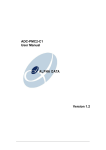



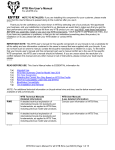

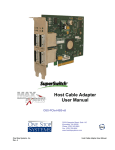





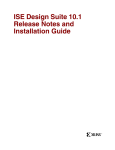

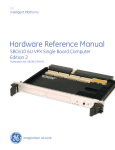
![[Insert the picture here]](http://vs1.manualzilla.com/store/data/005750886_1-61b7896b0a61bec1f004b64a994fc9d3-150x150.png)
